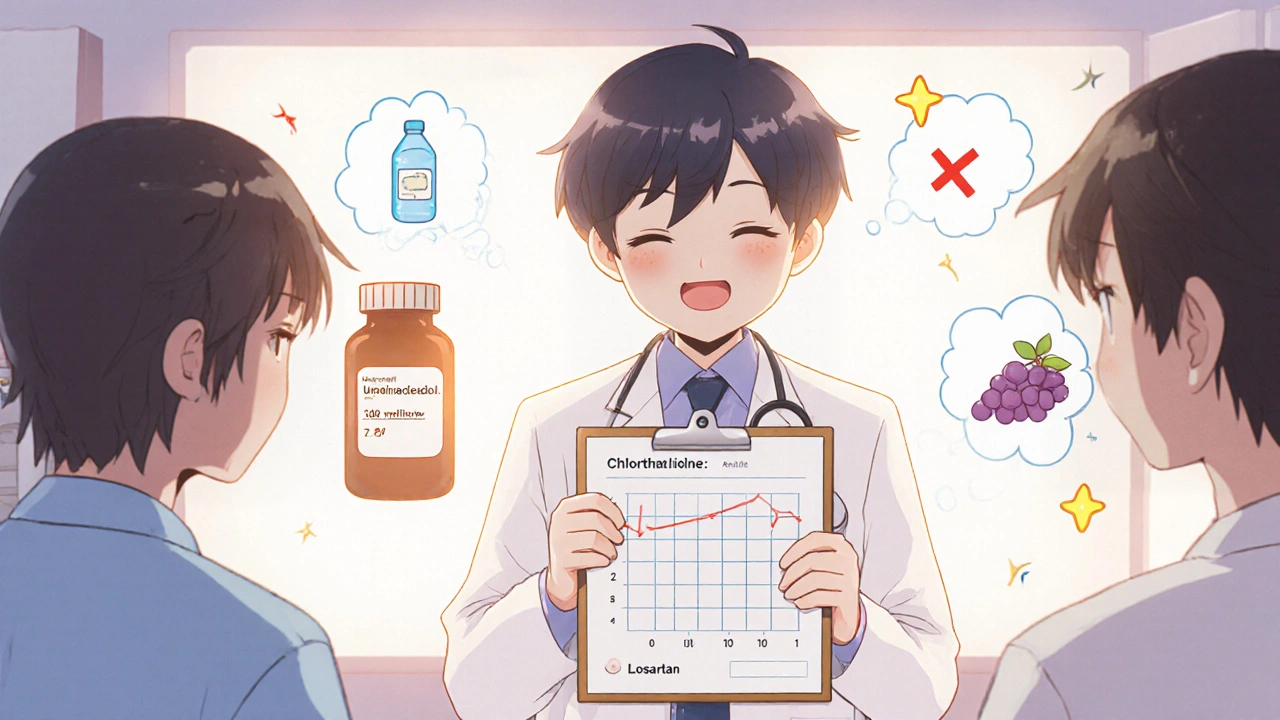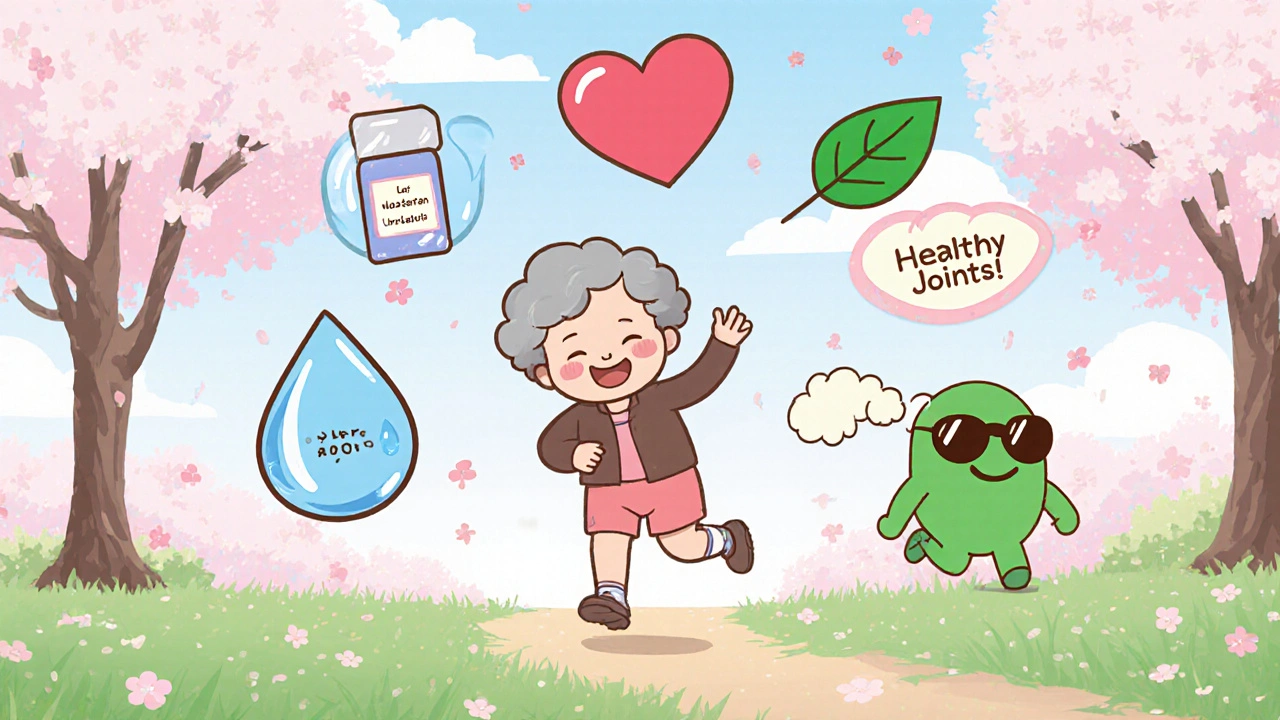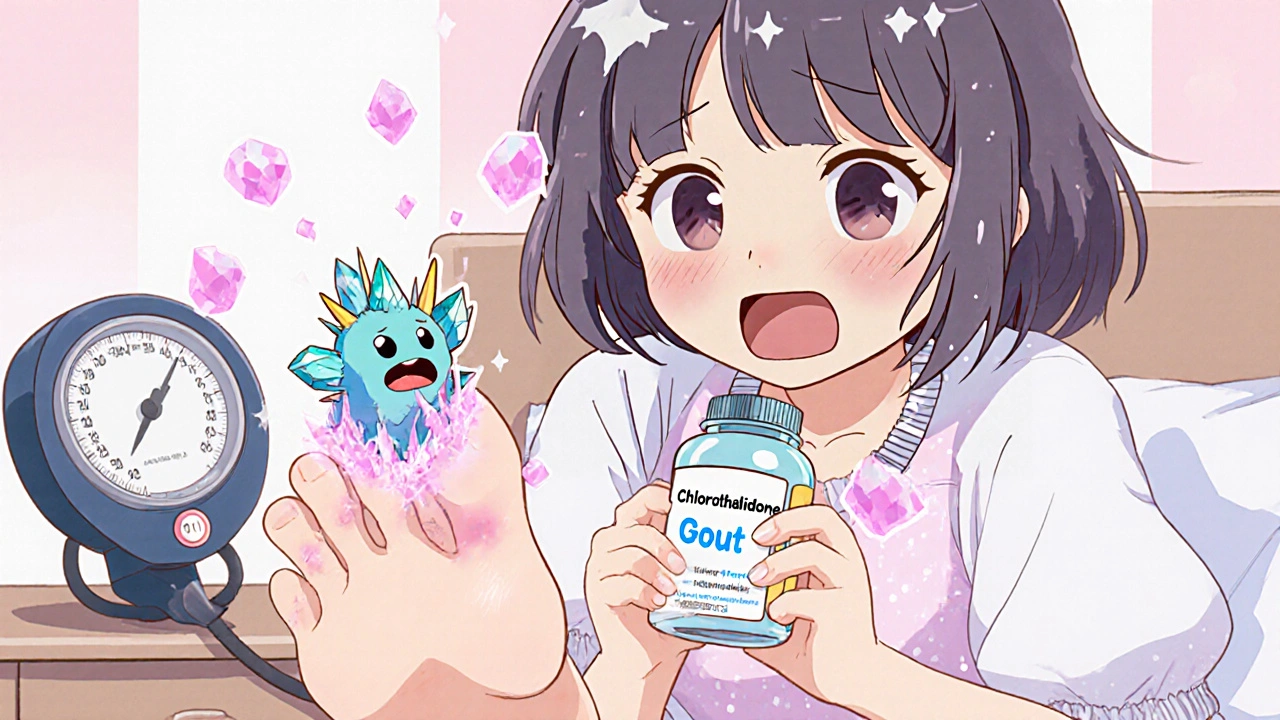If you're taking chlorthalidone for high blood pressure and suddenly notice swelling or sharp pain in your big toe, you're not alone. Many people don’t realize that this common blood pressure pill can make gout worse-or even trigger it for the first time. It’s not a rumor. It’s backed by real studies and clinical experience. And if you’re one of the 9 million Americans living with gout, this could matter more than you think.
What is chlorthalidone?
Chlorthalidone is a thiazide-like diuretic, often called a water pill. It’s been used since the 1950s to treat high blood pressure and fluid retention. Unlike some newer diuretics, chlorthalidone works longer in the body-sometimes up to 72 hours-and it’s more potent at lowering blood pressure over time. That’s why doctors still prescribe it, especially for patients who need strong, steady control.
It works by telling your kidneys to flush out more sodium and water. Less fluid in your blood vessels means lower pressure. Simple. Effective. But here’s the catch: when your kidneys push out sodium, they also pull out other things-like uric acid. And that’s where gout comes in.
What is gout?
Gout is a type of inflammatory arthritis caused by too much uric acid in the blood. When uric acid builds up, it forms sharp, needle-like crystals in your joints-most often the big toe, but also ankles, knees, and fingers. These crystals trigger intense pain, redness, heat, and swelling. Attacks can last days or weeks. Some people get them once a year. Others get them monthly.
Uric acid comes from the breakdown of purines, which are found in foods like red meat, shellfish, and beer. But your body also makes it naturally. If your kidneys can’t clear it fast enough, levels rise. And that’s exactly what chlorthalidone can interfere with.
How chlorthalidone affects uric acid
Studies show chlorthalidone reduces how much uric acid your kidneys excrete. One 2019 analysis in Journal of the American Heart Association found that people taking chlorthalidone had uric acid levels rise by an average of 1.2 mg/dL within the first few weeks. That’s a big jump-enough to push someone from normal (under 6 mg/dL) into the gout-risk zone (above 7 mg/dL).
Compare that to hydrochlorothiazide, another common diuretic. It also raises uric acid, but less so. Chlorthalidone is about twice as strong in this effect. That’s why patients who’ve had gout before are often warned: if you’re on chlorthalidone, your risk of flare-ups goes up.
One 2021 study in Arthritis & Rheumatology tracked over 12,000 people with hypertension. Those on chlorthalidone were 35% more likely to have a gout attack in the first year than those on other blood pressure meds. The risk didn’t drop after a year-it stayed high.

Who’s most at risk?
Not everyone on chlorthalidone gets gout. But certain people are much more likely to:
- Already have high uric acid levels (even if they never had symptoms)
- Have had gout before
- Are overweight or have metabolic syndrome
- Drink alcohol regularly, especially beer or spirits
- Eat a lot of red meat, organ meats, or shellfish
- Are over 65
Men are more likely than women to develop gout, especially before age 65. But after menopause, women’s risk rises sharply. So if you’re a woman over 60 on chlorthalidone and suddenly feel joint pain, don’t brush it off as arthritis. Ask about gout.
What to do if you’re on chlorthalidone and have gout
If you’ve been diagnosed with gout and are taking chlorthalidone, you have a few options. You don’t have to stop your blood pressure treatment-but you do need to rethink your meds.
First, talk to your doctor about switching to a blood pressure drug that doesn’t raise uric acid. Good alternatives include:
- Losartan (Cozaar): This is an ARB that actually helps lower uric acid. It’s a double win-lowers blood pressure and reduces gout risk.
- Calcium channel blockers like amlodipine: These don’t affect uric acid levels at all.
- ACE inhibitors like lisinopril: Mildly protective against gout, though not as strong as losartan.
If switching isn’t possible right away, your doctor might add a gout-prevention drug like allopurinol or febuxostat. These lower uric acid production. Or they might prescribe colchicine to prevent flares.
Don’t try to manage this alone. Gout isn’t just about pain-it’s linked to heart disease, kidney damage, and diabetes. Controlling your blood pressure and uric acid together is key.
What if you’ve never had gout but are on chlorthalidone?
You don’t need to panic. But you should be aware. Ask your doctor for a simple blood test: serum uric acid. Normal is under 6 mg/dL for women and under 7 mg/dL for men. If yours is above 7, you’re in the danger zone.
Even if your level is normal, watch for early signs: sudden joint pain, especially at night; redness or warmth in a joint; swelling that comes and goes. These could be gout flares you’re not recognizing.
Make small lifestyle changes to lower your risk:
- Drink plenty of water-aim for 2 to 3 liters a day. It helps flush out uric acid.
- Lose weight if you’re overweight. Even 5-10 pounds can cut your gout risk in half.
- Avoid sugary drinks, especially soda with high-fructose corn syrup. It spikes uric acid.
- Limit alcohol, especially beer and hard liquor. Wine is less risky.
- Reduce red meat, organ meats, and shellfish. Try plant-based proteins like lentils and tofu instead.

Why this matters beyond the joint pain
Gout isn’t just a painful nuisance. It’s a sign your body is struggling with metabolism. People with gout have higher rates of high blood pressure, kidney disease, heart attacks, and diabetes. And if you’re on chlorthalidone, you’re already managing one of those conditions.
That means your treatment plan needs to be holistic. Fixing your blood pressure shouldn’t make your gout worse. And treating gout shouldn’t make your blood pressure harder to control.
Chlorthalidone is a powerful tool. But like any tool, it has trade-offs. The goal isn’t just to lower numbers-it’s to keep you healthy overall.
When to see a doctor
Don’t wait for a full-blown gout attack. See your doctor if:
- You’re on chlorthalidone and have joint pain you can’t explain
- Your uric acid level was ever above 7 mg/dL
- You’ve had a gout flare in the past, even if it was years ago
- You’re noticing swelling in your feet or ankles that doesn’t go away
Bring your medication list. Ask: "Is chlorthalidone the best choice for me, given my health history?" If your doctor says yes, ask: "What signs should I watch for? What’s my uric acid level?"
Bottom line
Chlorthalidone is effective for high blood pressure-but it can raise your risk of gout. If you have gout, or are at risk, talk to your doctor about alternatives. You don’t have to choose between healthy blood pressure and healthy joints. There are better combinations out there.
Know your numbers. Watch your symptoms. Ask questions. Your body is telling you something. Listen.
Can chlorthalidone cause gout even if I’ve never had it before?
Yes. Chlorthalidone reduces how much uric acid your kidneys remove, which can cause levels to rise. Even if you’ve never had gout, a uric acid level above 7 mg/dL can lead to crystal formation and your first gout attack. This is especially true if you’re overweight, drink alcohol, or eat a lot of meat or seafood.
Is hydrochlorothiazide safer than chlorthalidone for gout?
Hydrochlorothiazide also raises uric acid, but studies show chlorthalidone has a stronger effect. It’s more potent and lasts longer, so it tends to cause bigger spikes in uric acid levels. If you have gout or high uric acid, neither is ideal-but hydrochlorothiazide may be slightly less risky at lower doses.
What blood pressure meds are safe for people with gout?
Losartan (Cozaar) is the best option-it lowers both blood pressure and uric acid. Calcium channel blockers like amlodipine and ACE inhibitors like lisinopril are also safe choices. Avoid diuretics like chlorthalidone and hydrochlorothiazide unless absolutely necessary.
Should I stop taking chlorthalidone if I get gout?
Don’t stop on your own. Stopping suddenly can spike your blood pressure. Talk to your doctor. They may switch you to a different medication or add a gout-prevention drug like allopurinol. Many people manage both conditions successfully with the right combo.
Can diet alone prevent gout while taking chlorthalidone?
Diet helps, but it’s not enough on its own. Even with a clean diet, chlorthalidone can still raise uric acid levels because it affects how your kidneys work. You’ll need medication adjustments or additional drugs like colchicine or allopurinol to fully protect yourself.

 Nov, 18 2025
Nov, 18 2025

Nick Lesieur
November 19, 2025 AT 06:49Angela Gutschwager
November 19, 2025 AT 15:17Andy Feltus
November 20, 2025 AT 06:22Dion Hetemi
November 20, 2025 AT 20:04Kara Binning
November 22, 2025 AT 18:37river weiss
November 24, 2025 AT 17:35Brian Rono
November 25, 2025 AT 14:58Zac Gray
November 26, 2025 AT 08:56Steve and Charlie Maidment
November 27, 2025 AT 11:40